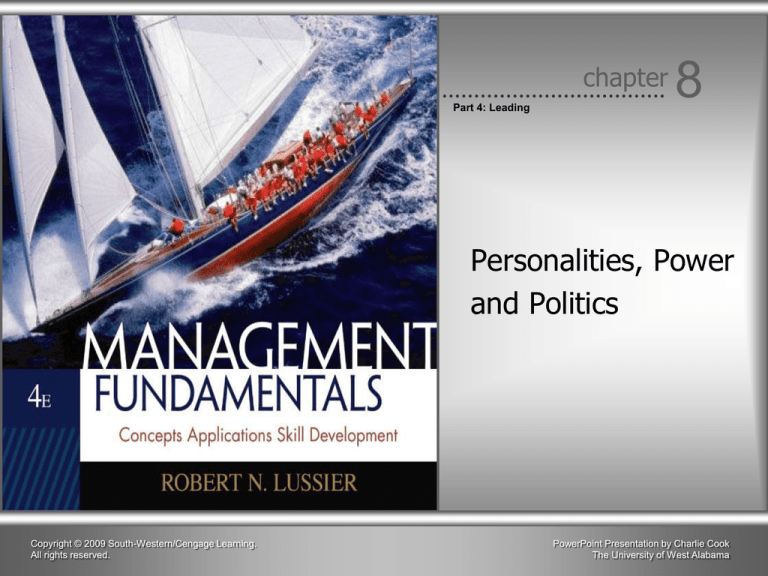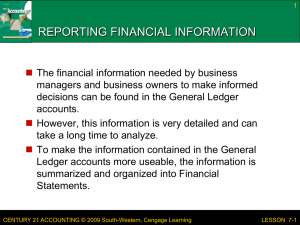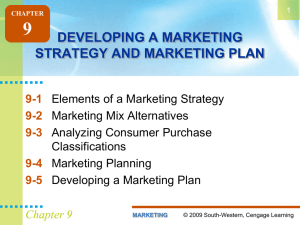
chapter
Part 4: Leading
8
Personalities, Power
and Politics
Copyright © 2009 South-Western/Cengage Learning.
All rights reserved.
PowerPoint Presentation by Charlie Cook
The University of West Alabama
Organizational Behavior
• Organizational Behavior
The study of actions that affect performance in the
workplace.
The goal of organizational behavior theorists is to
explain and predict actions and how they will affect
performance.
The field of organizational behavior has three levels
of focus: the individual, the group, and the
organization.
Individual behavior-3 things-personality, perception,
and attitudes
Copyright © 2009 South-Western/Cengage Learning. All rights reserved.
8–2
Personality
• Personality
A combination of behavioral, mental, and emotional
traits that define an individual.
Based on genetics and environmental factors.
Affects behavior as well as perceptions and attitudes.
Copyright © 2009 South-Western/Cengage Learning. All rights reserved.
8–3
Single Traits of Personality
• Locus of Control
Lies on a continuum between believing that control
over one’s destiny is external (externalizers) and
believing that it is internal (internalizers).
• Optimism versus Pessimism
Lies on a continuum whose opposite end is
pessimism.
• Risk Propensity
Lies on a continuum from risk taking to risk avoiding.
• Machiavellianism
Based on the belief that the ends can justify the
means and power should be used to reach desired
ends.
Copyright © 2009 South-Western/Cengage Learning. All rights reserved.
8–4
The Big Five Personality Dimensions
From
Trait
To
Extrovert
Extraversion
Introvert
Cooperative
Agreeableness
Competitive
Emotionally
stable
Emotionalism
Emotionally
unstable
Responsible/
Dependable
Conscientiousness
Irresponsible/
Undependable
Willing to try
new things
Openness to Experience
Not willing to
try new things
Trait Continuum
Copyright © 2009 South-Western/Cengage Learning. All rights reserved.
8–5
How about some examples of these
Personality Traits? Examples from the movies….
• John Bender (Judd Nelson) – Big five personality dimensions: High on extraversion and
openness to experience; low on emotional stability, agreeableness, and conscientiousness.
• Brian Ralph Johnson (Anthony Michael Hall) – Big five personality dimensions: High on
emotional stability, agreeableness, conscientiousness, and openness to experience; moderate on
extraversion. Type B personality.
• Allison Reynolds (Ally Sheedy) – Big five personality dimensions: High on extraversion and
openness to experience; low on emotional stability, agreeableness, and conscientiousness. Type
A personality.
• Claire Standish (Molly Ringwald) – Big five personality dimensions: High on extraversion and
conscientiousness; moderate on emotional stability, agreeableness, and openness to experience.
Strongest Type A personality of the four characters in the scene.
•
• The following are the nicknames for each character shown in the scene:
• The Criminal – Bender
• The Brain – Brian
• The Kook – Allison
• The Princess – Claire
•
• Note: Students familiar with the Lunchtime sequence might ask about the absence of Andrew
Clark, The Jock (Emilio Estevez). We edited him out of the scene because he would not approve
the use of his image.
Copyright © 2009 South-Western/Cengage Learning. All rights reserved.
8–6
What personality traits do YOU have?
• Take the Self Assesment on pg. 276
Copyright © 2009 South-Western/Cengage Learning. All rights reserved.
8–7
Perception
• Perception
The process of selecting, organizing, and interpreting
environmental information.
Self-esteem (self-concept)
Your perception of yourself.
Self-efficacy
The belief in your own capability to perform in a specific
situation.
Copyright © 2009 South-Western/Cengage Learning. All rights reserved.
8–8
The Attribution Process
• Attribution
The process of determining the reason for an
individual’s behavior and whether that behavior is
either situational (out of the control of the individual)
or intentional (the individual is consciously
behaving).
Copyright © 2009 South-Western/Cengage Learning. All rights reserved.
8–9
Exhibit 8–1 ● The Attribution Process
Copyright © 2009 South-Western/Cengage Learning. All rights reserved.
8–10
Bias in Perception
• Selectivity
Screening information in favor of the desired
outcome.
• Frame of Reference
Seeing things from your point of view rather than
another’s.
• Stereotypes
The process of generalizing the behavior of a group
and then applying the generalities to one individual.
• Expectations
Perceiving what is expected to be perceived.
Copyright © 2009 South-Western/Cengage Learning. All rights reserved.
8–11
Attitudes
• Attitudes
Positive or negative evaluations of people, things, and
situations.
• Attitude Formation
Attitudes are based on perceptions.
• Attitudes and Behavior
Attitudes reflect feelings and affect behavior.
• Pygmalion Effect
Managers’ attitudes toward and expectations of
employees and how they treat them largely determine
employee performance.
Copyright © 2009 South-Western/Cengage Learning. All rights reserved.
8–12
Attitudes and Job Satisfaction
• Job Satisfaction
A person’s attitude toward his or her job.
Generally measured along a continuum from
satisfied/positive/high to dissatisfied/negative/low.
• Job Satisfaction and Performance
Affects absenteeism and turnover.
Citizenship behavior
Employee efforts to go above and beyond the call of duty.
• Determinants of Job Satisfaction
Personality, the work itself, compensation, growth and
upward mobility, coworkers, management
Copyright © 2009 South-Western/Cengage Learning. All rights reserved.
8–13
Power
• Power
The ability to influence others’ behavior.
• Sources of Power
Position power
Derived from top management and is delegated down the
chain of command.
Personal power
Derived from followers, based on an individual’s behavior.
A charismatic leader has personal power. Ie James Jones
Empowerment
Even though power starts at the top, today top managers are
giving power to employees.
Copyright © 2009 South-Western/Cengage Learning. All rights reserved.
8–14
Power (cont’d)
• How to Increase Your Power
You can increase your power without taking power
away from others.
Generally, power is given to those who get results
and have good interpersonal skills.
Copyright © 2009 South-Western/Cengage Learning. All rights reserved.
8–15
Types of Power
• Coercive Power
Involves threats and/or punishment to influence
compliance.
• Connection Power
Based on the user’s relationship with influential
people. “It’s not what you know, it’s who you know.”
Can be helpful in your management career. Do
networking to develop important connections with
important managers up the ladder. Make alliances.
• Reward Power
Based on the user’s ability to influence others by
providing something of value to them. “win-win”
Copyright © 2009 South-Western/Cengage Learning. All rights reserved.
8–16
Types of Power (cont’d)
• Legitimate Power
Based on the user’s position power in the organization.
• Referent Power
Based on the user’s personal power relationships with others.
Requesting someone do something instead of giving an order.
To get more referent power, make efforts to gain others’ confidence in
you.
• Information Power
Based on others’ need for data.
To get more information power, know what’s going on in the business.
Serve on committees. Give service and info to other depts.
• Expert Power
Based on the user’s skills and knowledge. The “go to guy”.
To get more expert power, go to training programs, volunteer, be willing
to take on the more complex tasks.
Copyright © 2009 South-Western/Cengage Learning. All rights reserved.
8–17
Exhibit 8–2 ● Type of Power
Copyright © 2009 South-Western/Cengage Learning. All rights reserved.
8–18
Copyright © 2009 South-Western/Cengage Learning. All rights reserved.
8–19
Organizational Politics
• Politics
The process of gaining and using power.
• Political Behaviors
Networking
The process of developing relationships for the purpose of
socializing and career building.
Reciprocity
The creation of obligations and the development of alliances
that are used to accomplish objectives.
Coalition Building
A network of alliances that help a manager achieve an
objective.
Copyright © 2009 South-Western/Cengage Learning. All rights reserved.
8–20
Exhibit 8–3 ● Political Behaviors and Guidelines for Developing Political
Skills
Copyright © 2009 South-Western/Cengage Learning. All rights reserved.
8–21
Copyright © 2009 South-Western/Cengage Learning. All rights reserved.
8–22
One example of motivating your
employees…the Art Friedman way
• About Friedman’s Appliance Store-pg 408 of text
• Enter the world of Art Friedman
Copyright © 2009 South-Western/Cengage Learning. All rights reserved.
8–23









